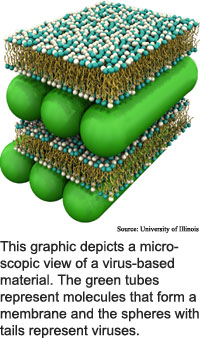
Virus forms nano template
Living matter self-assembles into complex
organisms that can contain billions of cells, and researchers have tapped
biological molecules like DNA and viruses to self-assemble technologically
useful structures and materials.
Researchers from the University of Illinois at Urbana-Champaign
and Brown University have showed how self-assembly mechanisms that bring
together charged membranes and oppositely charged polymers like biological
molecules can be understood in terms of simple rules, and have applied
the rules to make virus-membrane complexes with pore sizes that can be
used to organize molecules.
These complexes are made from alternating layers of membranes
and viruses. They could be used as scaffolds to build nanostructures or
as drug delivery systems, according to the researchers.
Existing DNA-membrane complexes have pore sizes that are too small
to organize large molecules like proteins. The researchers' virus-membrane
complexes, which use a bacteria-infecting virus, have pore sizes of about
10 nanometers, which is about 10 times larger than DNA-membrane complexes.
The researchers used the virus-membrane complex to capture and
arrange arrays of ruthenium ions, which are relatively large at 1.2 nanometers
in diameter. The ruthenium ion is used as a fluorescent dye.
Self-assembled virus-membrane complexes could be used in practical
applications in 10 to 20 years, according to the researchers. The work
appeared in the August 15, 2004 issue of Nature Materials.
Fuel cell converts waste to power
Bank transfer demos quantum crypto
Agent model yields leadership
Flexible sensors make robot skin
Briefs:
Microscope etches ultrathin lines
Nanowire makes standup transistor
Plastics ease nanotube circuits
Virus forms nano template
Photo molecules flip current
Nanotubes on cloth fire electrons

Research Watch blog
View from the High Ground Q&A
How It Works
RSS Feeds:
News
Ad links:
Buy an ad link
Ad links: Clear History
Buy an ad link
|
TRN
Newswire and Headline Feeds for Web sites
|
© Copyright Technology Research News, LLC 2000-2010. All rights reserved.